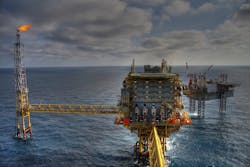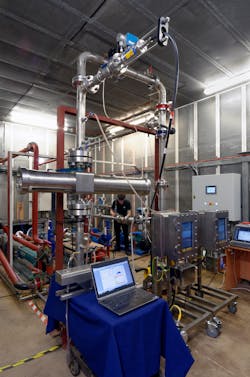Minimizing produced water’s impact on the environment
Produced water is an inevitable by-product of oil and gas production that contains a wide range of contaminants including hydrocarbons, soluble organics, heavy metals, radioactive materials, and dissolved gases. As a result, the discharge of produced water is strictly regulated to avoid potential harm to the marine environment and therefore good management and measurement practice is crucially important. With increasing water production from mature fields and the move toward deepwater production, chemical enhanced oil recovery, heavy oil, and unconventional oil and gas production, the oil and gas industry is facing a significant number of challenges with management of this produced water, which requires a multi-disciplinary and holistic approach.
The key to produced water management is to prevent water getting into the wellbore and to minimize the water brought to the surface. Failing to do this would require produced water to be treated, reinjected, and/or discharged or reused. While management of produced water varies among operators, geographical locations, and field history, good practice should involve different disciplines, such as reservoir, production, and environmental engineers, alongside production chemists.
The accurate measurement of produced water is vital, with the data collected informing future government regulations and corporate environmental policy. To calculate the total amount of oil that is discharged during the release of produced water, the volume of produced water, as well as the concentration of oil in water, need to be measured accurately.
Online Oil-in-Water Monitors
How to best manage produced water in oil and gas production has a significant impact economically, socially, and environmentally, and the use of online oil-in-water monitors can play an important role.
Whether produced water brought to the surface is treated and then either discharged to the environment or reinjected back into a formation, its quality must be measured. Laboratory benchtop measurement methods require samples to be brought into the laboratory for analysis, and this process can create health, safety, and environmental (HSE) issues. Also, as subsea separation and produced water reinjection (PWRI) and/or discharge are becoming increasingly considered by oil and gas operators, an alternative measurement method offers great advantage.
The use of online monitors can also significantly reduce the number of samples taken for laboratory analyses and therefore minimize the use of solvents that are normally required for laboratory oil-in-water analyses. Also, online monitors offer high-frequency measurement. This should deliver more accurate oil-in-produced-water discharge data than manual methods, which generally rely on two daily samples analyzed in the laboratory.
Preliminary studies undertaken by TÜV SÜD National Engineering Laboratory indicate there is a large uncertainty associated with oil-in-water data obtained using laboratory-based methods, with the uncertainty possibly being as high as ±50 percent (at 95 percent confidence level). The use of online oil-in-water monitors, in particular those installed inline, could potentially reduce the uncertainties associated with the current sampling and analysis practice.
To date, online oil-in-water monitors have been predominately used for process trending and optimization purposes for surface installations, but there is now a strong need in the oil and gas industry to use them for produced water discharge reporting purposes. For subsea applications, discharge and/or reinjection of subsea separated produced water would be extremely difficult, if not impossible, without a reliable and accurate online oil-in-water measurement instrument. The industry therefore needs to develop new guidelines and new approaches to be confident in their use for this application.
Industry Collaboration Vital for Research
To help the industry address produced water issues more effectively, TÜV SÜD National Engineering Laboratory welcomed more than 100 organizations around the world into its Produced Water Club, with over 30 international conferences held in the last two decades. Club activities have resulted in the launch of a series of joint industry projects ( JIPs), including the following.
Oil-in-Water Analysis Methods JIP
Oil-in-water concentration used to be measured by extracting oil from a water sample using Freon-113 (a solvent that was known to cause ozone depletion and damage to the environment), and then analyzed using an infrared absorption-based instrument.
The JIP was supported by both the UK and Dutch regulators, together with eight offshore operators. The objective of the study was to prepare the North Sea industry for a smooth transition from the old infrared-based method to a new OSPAR (Oslo and Paris) gas chromatography and flame ionization detection (GC-FID)-based method.
The key outcome of the JIP was the development of the OSPAR and the UK Department of Energy and Climate Change (DECC), now known as the Department of Business, Energy and Industrial Strategy (BEIS), guidelines for oil-in-water sampling and measurement. These guidelines are still being used today.
Produced Water Volume Determination JIP
To calculate the total amount of oil being discharged into the sea via the discharge of produced water, accurate measurements of both oil in produced water concentration and discharge volume are required.
One of TÜV SÜD National Engineering Laboratory’s early surveys indicated that estimations of produced water discharge volume by the operators were done using a variety of methods, resulting in a huge variation in terms of uncertainties associated with the measurement of the produced water volume that was discharged.
This JIP was initiated to improve the understanding of existing practices and to develop produced water volume verification procedures and guidelines. Ultimately, the project was aimed at helping the operators to improve produced water management and to assist the UK in meeting a 15 percent reduction target in discharge of oil via the discharge of produced water. The JIP was supported by the UK regulator together with five operators, and its outcome was a sponsor-wide best practice guidance on how to determine produced water volume.
Making Online (OiW) Analyzers for Reporting
To fill the knowledge gaps relating to using online oil-in-water monitors, improve existing oil-in-water measurement guidelines, and make the use of these monitors for produced water discharge reporting a common practice, TÜV SÜD National Engineering Laboratory’s most recent JIP saw five operators and a government regulator supporting the project. The project was formally initiated in October 2019 and will last over nine months.
Specific objectives of the JIP are:
• To provide a status report on online oil-in-water monitoring technologies and also on the uses of online analyzers
for reporting purposes
• To understand and establish uncertainties associated
with oil-in-water sampling and measurements
• To refine acceptance criteria for using online oil-in-water
analyzers for reporting purposes
• To develop regulatory requirements for subsea discharges
• To develop guidance for accepting online oil-in-water analyzers for unmanned and subsea applications
• To propose a set of changes to be made for the existing OSPAR, BEIS and Norsk Olje & Gas O85 guidance in relation to using online oil-in-water analyzers
Conclusion
As produced water is a by-product of oil and gas production, its effective management is critically important for the safe and economical production of oil and gas. The uses of online oil-in-water monitors can play a significant role in production process control and optimization, injection water quality monitoring, and discharge reporting. With technology advancements, an improved perception, a better understanding of the uncertainties associated with the exiting sampling and measurement practice, and continued efforts from industry, we will see an increased use of online oil-in-water monitors for the management of produced water. They will become increasingly common on manned, unmanned, and subsea installations, not only for operations but also for the purposes of produced water discharge reporting. WT
About the Author

Ming Yang
Dr. Ming Yang is a principal consultant at TÜV SÜD National Engineering Laboratory, a global center of excellence for flow measurement and fluid flow systems. A world-class provider of technical consultancy, research and development, testing, and calibration services to the oil and gas, water and energy sectors, the company is the UK’s Designated Institute for Flow and Density measurement, under contract from BEIS, and part of the UK’s National Measurement System.

